laurie anderson: do dogs aspire to nirvana?
gail priest: laurie anderson, adelaide festival
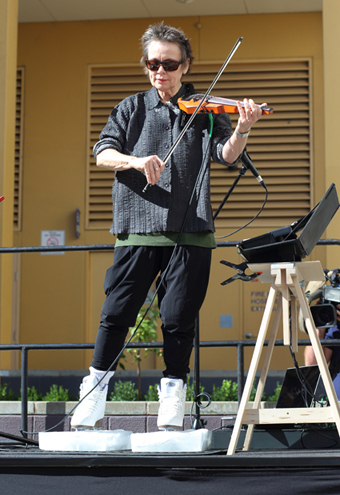
Laurie Anderson, Duets on Ice, Adelaide Festival 2013
photo Tony Lewis
Laurie Anderson, Duets on Ice, Adelaide Festival 2013
LAURIE ANDERSON IS MOST FREQUENTLY SEEN IN LARGE VENUES SHARING SHORT STORIES AND PERSONAL PHILOSOPHY, UNDERPINNED BY GENERALLY HUMMABLE TUNES, SO IT’S NOT SURPRISING THAT SOME MAY QUERY HER UBIQUITOUS BRANDING AS ‘EXPERIMENTAL.’ SHE HERSELF ADMITS TO OFTEN FEELING MORE LIKE A JOURNALIST THAN A DOYENNE OF THE AVANT-GARDE (GRITTV, 2011).
A long-time fan of Laurie Anderson, even I had begun to question how close to the experimental coalface she was operating these days. However the presentation of three major projects as part of the 2013 Adelaide Festival confirmed for me that Anderson’s experimentalism is not something accurately gauged via a single artwork, rather it arises from her consistently multi-disciplinary approach over a 40-year career.
present pasts
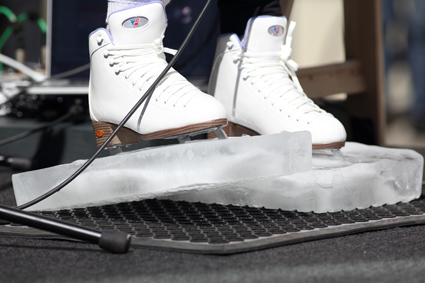
Laurie Anderson, Duets on Ice, Adelaide Festival 2013
photo Tony Lewis
Laurie Anderson, Duets on Ice, Adelaide Festival 2013
I arise obscenely early to get to Adelaide from Sydney by 10.30am for Anderson’s performance of Duets on Ice which opens her exhibition The Language of the Future at the Anne and Gordon Samstag Museum of Art. Back in the 1970s Anderson augmented a violin so that it played tape loops allowing her to duet with herself. The loop made the performance potentially endless so Anderson introduced a timing device: embedding ice-skates into blocks of ice, she would play until the ice melted.
Taking place outside the gallery in Adelaide heat, I suspect the performance might be short so I am keen to get there on time. I am a little disappointed that Anderson has replaced her tape-loop violin for her current rig—electric violin filtered through various digital systems—but of course technologies move on and Anderson is well-known for being adaptive and adoptive. It’s not at all disappointing to watch Anderson, a petite woman in her 60s, awkwardly ambulating across the Samstag courtyard to the makeshift stage, large blocks of ice attached to her bright white ice-skating boots. This is an informal and intimate performance (so rare to see experimental music in daylight) and Anderson semi-improvises and chats for 25 minutes, the time it takes for the ice to crack and break away from the skates.
The Language of the Future features five pieces illustrating the breadth of Anderson’s work as visual artist. The centre-piece is The Swimmer (2009-2012), a six-channel video down-projected along the length of the space. The projection surface is made from shredded paper in tight, tiny rolls, the printed text just visible if you peer closely. Seen on the ground floor it adds visual noise to the images creating a kind of analogue pixilation. Viewed from the balcony it appears more three-dimensional—a memory contour map perhaps.
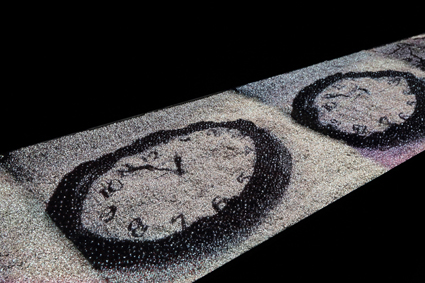
Laurie Anderson, The Swimmer (2009-2012), The Language of Future, Anne & Gordon Samstag Museum of Art
courtesy Adelaide Festival 2013
Laurie Anderson, The Swimmer (2009-2012), The Language of Future, Anne & Gordon Samstag Museum of Art
The video is a visual poem comprising fragmented images—rural scenes, the looming face of a nurse, clockfaces and a rabbit in a wheelchair—some in high-contrast black and white, others in dreamy colour. The images accompany the adjacent piece, A Story About a Story (2012), an artist book exploring the time Anderson broke her back as a child and spent months recuperating in a ward for seriously ill children. It’s Anderson at her most revealing as she admits to subsequently editing out details—the real horror of the situation—in the process of crafting the story into one of her set pieces. She concludes, “You get your story and you hold onto it and every time you tell it you forget it more.”
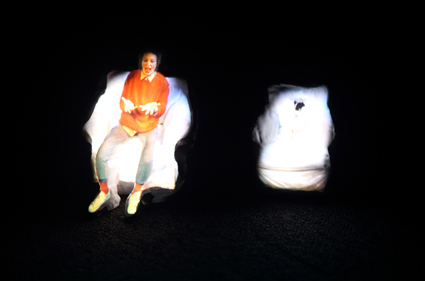
Laurie Anderson, From the Air (2008); The Language of the Future, Anne & Gordon Samstag Museum of Art
courtesy Adelaide Festival 2013
Laurie Anderson, From the Air (2008); The Language of the Future, Anne & Gordon Samstag Museum of Art
The use of a three-dimensional projection surface is something Anderson began in 1977 with her “fake hologram” At the Shrink. She projected an image of herself onto a small three-dimensional plaster figure, giving a beguiling sense of depth and life. From the Air (2008) revisits this technique presenting tiny models of herself and her dog Lolabelle. The Anderson figure tells the story of the time her dog was swooped on by turkey vultures but then deftly flips this domestic moment to reflect the state of American consciousness after 9/11—when people realised, like Lolabelle, that “They can come from up there!”
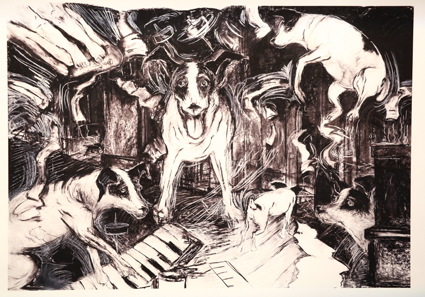
Laurie Anderson, Lolabelle in the Bardo, The Language of Future, Anne & Gordon Samstag Museum of Art
courtesy Adelaide Festival 2013
Laurie Anderson, Lolabelle in the Bardo, The Language of Future, Anne & Gordon Samstag Museum of Art
Lolabelle also makes an appearance in a series of prints taken from large-scale drawings depicting the rat terrier, now deceased, spending 49 days in the Bardo, the place Buddhists believe souls go before they are reborn. The rendering of the dog is cartoon-like yet the images are quite terrifying, full of turbulent motion and dark twisted figures. Lolabelle in the Bardo shows an artist willing to defy expectations and utilise whatever medium suits her project.
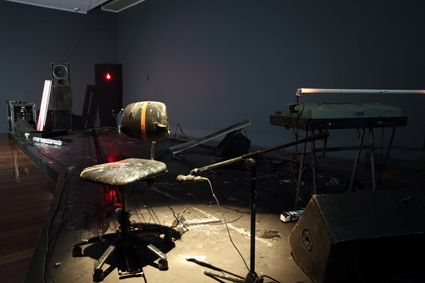
Laurie Anderson, Electric Chair, The Language of Future, Anne & Gordon Samstag Museum of Art
courtesy Adelaide Festival 2013
Laurie Anderson, Electric Chair, The Language of Future, Anne & Gordon Samstag Museum of Art
Similar idiosyncrasy is revealed in the final work, The Electric Chair. An installation from 1977, it was originally presented in a rundown warehouse using whatever was at hand, but now it is recreated in one of Australia’s newer white cubes. The sounds in this piece—the amplified hum and stutter of fluorescent tubes on the blink, the thump and grind of a swivel chair careening up and down a rail—have more rawness and authenticity than the faux paint-spattered floor and distressed electrical equipment. Ironic and playful, Electric Chair adds historical perspective to the survey—even Laurie Anderson started out in a dirty warehouse.
While not a comprehensive retrospective of Anderson’s oeuvre, the selected works in The Language of the Future rustle against each other in a way that highlights her dominant methodologies: multidisciplinarity; multi-dimensionality; the interplay of textual and visual poesy; and the personal as political.
connecting dots
If Language of the Future doesn’t confirm her ‘experimental’ status, Landfall, Anderson’s collaboration with the Kronos Quartet, certainly does. It explores what she describes as the processes of meaning-making by presenting the audience with fast flowing texts and symbols, conflicting audio and visual cues and an overall fragmentation that falls distinctly into the category of, to quote Anderson, “difficult music-c-c-c-c-c-c” (United States of America I-IV,1984).
The music alone doesn’t sound so difficult. Anderson’s electric violin forms a deep, rich bed over which the Kronos Quartet’s acoustic instruments shimmer. Nearly every musical segment is brief comprising beguiling melancholic melodies flavoured by Eastern European harmonies. It’s a music of beginnings with few pieces developing more complex internal structures, reminiscent of film scoring. It makes for a slippery, slightly frustrating experience—you long to hear some of the ideas expanded. It appears to be a deliberate tactic to aurally fragment the experience, just as the texts, spoken and projected, are broken up.
Subject matter is seemingly dissociative. Anderson was completing the commission when Hurricane Sandy hit New York so ideas of immersion flow through the piece. Near the beginning large text scrolls upwards, spaced and paced so that you are left to anticipate (often incorrectly) the next line:
“the city drowns
the city where children
are shot
and women have just
earned the right
to combat.”
At other times she talks of dreams, discussing how tedious it is when people recount them, which is ironic given that Anderson has spent much of her career sharing hers. There are texts about a book of extinct animals that weighs as much as 30 weasels; a job Anderson took to make a hotel lobby “sound bigger;” and a new letter of the alphabet called Olive which has no sound, you just open your mouth and think about it. These ideas weave around each other either spoken by Anderson or projected. The screened text comprises a variety of scrolling orientations, fonts and colours increasingly interrupted by typographic constructions, including warning and information symbols, silhouettes of figures replacing letters, ink splotches or simply missing chunks of words. We read, trying to fill the gaps. As William Burroughs says in “Sharkey’s Night,” “Hey sport. You connect the dots. You pick up the pieces” (Mister Heartbreak, 1984).
Laurie Anderson has always been associated with technological innovation, however in her later work she tends to let technology putter away in the background rather than fetishising it. In Landfall both tactics are employed. The program tells us that the composition is “generated from harmonies and delays” by the Erst software system—this perhaps explains the prevalent incremental build structure of most pieces. There is also interplay between the musicians and the text samples. This generally remains invisible except for one section in which violinist John Sherba breaks formation and solos, centre stage, generating flashes of words with sharp, frenetic bowing. Once again, I wished this had been extended beyond a brief moment of spectacle so that the cause and effect could develop more complexity.
Maybe Landfall is a little too genteel. The fragments themselves—both musical units and stories—are all quite pleasant and neat. A few more extremes and jagged edges, some freefall into utter ambiguity, might raise the stakes and make us work even harder in our role as meaning-makers.
story time
For those dissatisfied by the fragmentary nature of Landfall, the salve was Dirtday!. This is the Anderson we’ve come to expect. Stage and lighting design are stripped back but atmospheric, with small tea-light candles scattered around the floor adding warm shimmer to sharp beams of light. On stage is an armchair and next to it a small projection screen that remains mostly blank showing only shifting colours. While the chair is empty most of the time with Anderson positioned on the other side of the stage, its presence reminds us that this is story time.
After a brief musical introduction Anderson talks about evolution and how Darwin, “a mousey dresser,” was irked by the peacock, a species that allowed the female to make all the decisions. She moves on to the Catholic Church and its fear of multiple universes—what if there were multiple popes? Who would be top dog? And why is our planet called Earth? Why not simply Dirt?
Inevitably Anderson moves on to dreams—she tells us that at 63 she has dreamt for 21 years of her life. Now subjects begin to slip and intertwine: election seasons mix with peacocks, theories on cot death and tent cities, chickens in trees with the “politeness” of Alzheimer patients. Things consolidate again when Anderson finally sits in the armchair and talks about the death of her dog, ruminating on death from the Buddhist perspective: how to feel sadness but not be sad; how death is the release of love. From someone else’s lips all this could seem trite but Anderson’s touch is light and the inclusion of a crappy video of blind Lolabelle playing the keyboard a moment of leavening humour.
In her program notes Anderson discusses how she originally set out to make a music driven piece, utilising software that would render her solo playing symphonic, however the words just kept coming and she decided to go down the path of “musically arranged words that spoke up.” The music here is perfectly balanced, just rising above the background in swelling interludes then sinking back to keep things ticking over. Small details—the shudder of a helicopter, or the shimmer of rain, a dog bark, a pulsing beat—are near subliminal. Over the years Anderson’s use of the vocoder has also changed. Originally her down-pitched voice was used as the “voice of authority” but here she uses it as a more distant version of herself, her dream self. Perhaps she suggests our dream selves are our internal authority; or maybe they should be.
I had a moment of sadness during Dirtday! thinking that perhaps this might be the last time we see Anderson in Australia (given how far away we are from New York). If that is the case, these three projects presented by the Adelaide Festival offered the perfect showcase of the breadth and depth of this inspiring artist who is not afraid to keep doing what she knows she does well, but who also never wearies of the search for new ways to make sense of things.
Adelaide Festival 2013: The Language of the Future—Selected works from 1971-2012, Laurie Anderson, Anne & Gordon Samstag Museum of Art, March 1-April 19; Landfall, Laurie Anderson & The Kronos Quartet, performers Laurie Anderson, violin David Harrington, John Sherba, viola Hank Dutt, cello Jeffrey Ziegler, music and text Laurie Anderson, Erst programming Liubo Borrisov, electronics & software design Konrad Kaczmarek, dramaturg Bob Currie, transcription Jacob Garchik, audio rig Shane Koss, lighting design Brian H Scott, Festival Theatre, March 2; Dirtday!, music, text & visual design Laurie Anderson, lighting Brian H Scott, Dunstan Playhouse, March 3
RealTime issue #114 April-May 2013 pg. 6-7






